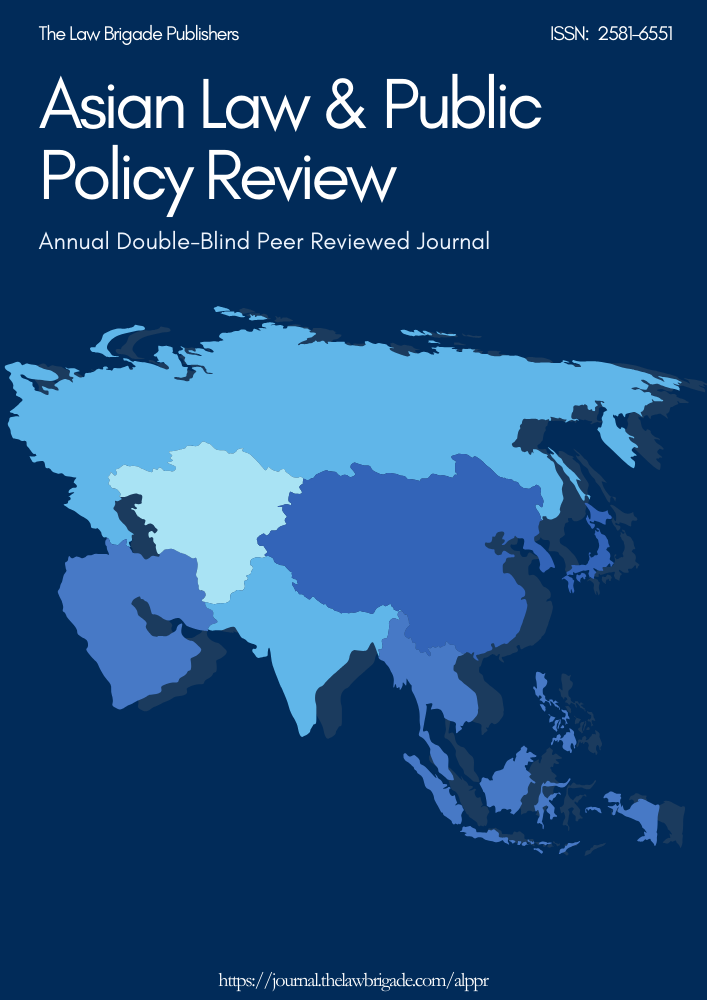CRIMINAL LIABILITY FOR INFRINGEMENT OF COPYRIGHT AND TRADEMARK IN INDIA VIS-À-VIS CHINA
Keywords:
Intellectual Property Rights (IPR), Anti Unfair Competition Law, Damages, The Trademark Law of the People’s Republic of ChinaAbstract
India and China ‘the Tiger vs. the Dragon’ - are always in head on to one another in every aspect of day-to-day activities. In the current era the Intellectual Property Rights is ruling the world and its presence are found in almost everything. The duo India and china have boomed as the prominent hubs for IPR and have always been the tough competitors to the whole world. While China on the other hand is the fastest booming economy and is one of the toughest competitors to the whole world as evident from its ranking of 14th position in the Global Innovation Index comparing to the 48th rank of India. It is to be viciously noted that China leads in the Special 301 Report prepared by the USTR, while India ranks 3rd . The legislations governing IPR in these two nations are rigid as well as flexible to some extent because of the need to comply with the growing demands globally. This automatically paves way for the similarities of provisions in these countries’ legislations to various extents, but in case of Criminal Liability for Infringement of Copyright and Trademark there are huge differences, thereby the Researcher concentrates on this area with the light on their remedies available. Therefore, the Researcher observes that one country has much stricter legislations and the other has the legislations which are slightly flexible and both the countries face instances of complexities in implementing the rules and legislations.
Downloads
References
, Indian Penal Code, 1860 - Cheating and dishonestly inducing delivery of property
xiii Judgment dated 25.11.2019 in W.P. (CRL) 3422/2018;
xiv Supra note 11
xv Article 48, The Copyright Law of the People’s Republic of China, 1990– Investigation of Criminal Liabilities
in accordance with the Laws;
xvi Supra note 2;
xvii The LEGO Group wins final decisions in major intellectual property lawsuits against LEPIN manufacturer in
China – https://www.lego.com/en-us/aboutus/news/2020/January/lepin-case - Last Visited February 8, 2020;
xviii Section 103, the Trademark Act, 1999 - Penalty for applying false trademarks, trade descriptions, etc;
xix Section 104, the Trademark Act, 1999 - Penalty for selling goods or providing services to which false trade
mark or false trade description is applied;
xx Section 105, the Trademark Act, 1999 - Enhanced penalty on second or subsequent conviction;
xxi Section 115, The Code of Criminal Procedure, 1973 - Power to dispense with personal attendance;
xxii Section 156, The Code of Criminal Procedure, 1973 - Police officer' s power to investigate cognizable case;
xxiii Section 19, The Code of Criminal Procedure, 1973 - Subordination of Metropolitan Magistrates;
xxiv Section 93, The Code of Criminal Procedure, 1973 - When search warrant may be issued;
xxv Notice of Motion (L) No 810 of 2019 in COMIP (L) No 383 of 2019;
xxviArticle 3, The Trademark Law of the People’s Republic of China, 1982: Registered Trademark;
xxviiArticle 57, The Trademark Law of the People’s Republic of China, 1982: Infringement of the exclusive right
to use a Registered Trademark;
xxviii Cynthia S. Wang, 2019. ‘China's Anti-Unfair Competition Law: Cracking Down On Malicious Infringement
In
Advertising’.www.mondaq.com/china/x/860774/Antitrust+Competition/Chinas+Antiunfair+Competition+Law+
cracking+down+on+malicious+infringement+in+advertising. Last Visited February 22, 2021
xxix Conseil Interprofessionnel du Vin de Bordeaux vs. Shanghai Feitong Trading Co., Ltd., June 4, 2020
xxx 2018.
Downloads
Published
Issue
Section
License

This work is licensed under a Creative Commons Attribution-NonCommercial-ShareAlike 4.0 International License.
License Terms
Ownership and Licensing:
Authors of research papers submitted to any journal published by The Law Brigade Publishers retain the copyright of their work while granting the journal specific rights. Authors maintain ownership of the copyright and grant the journal the right of first publication. Simultaneously, authors agree to license their research papers under the Creative Commons Attribution-ShareAlike 4.0 International (CC BY-SA 4.0) License.
License Permissions:
Under the CC BY-SA 4.0 License, others are permitted to share and adapt the work, even for commercial purposes, provided that appropriate attribution is given to the authors, and acknowledgment is made of the initial publication by The Law Brigade Publishers. This license encourages the broad dissemination and reuse of research papers while ensuring that the original work is properly credited.
Additional Distribution Arrangements:
Authors are free to enter into separate, non-exclusive contractual arrangements for distributing the published version of the work (e.g., posting it to institutional repositories or publishing it in books), provided that the original publication by The Law Brigade Publishers is acknowledged.
Online Posting:
Authors are encouraged to share their work online (e.g., in institutional repositories or on personal websites) both prior to submission and after publication. This practice can facilitate productive exchanges and increase the visibility and citation of the work.
Responsibility and Liability:
Authors are responsible for ensuring that their submitted research papers do not infringe on the copyright, privacy, or other rights of third parties. The Law Brigade Publishers disclaims any liability for any copyright infringement or violation of third-party rights within the submitted research papers.


